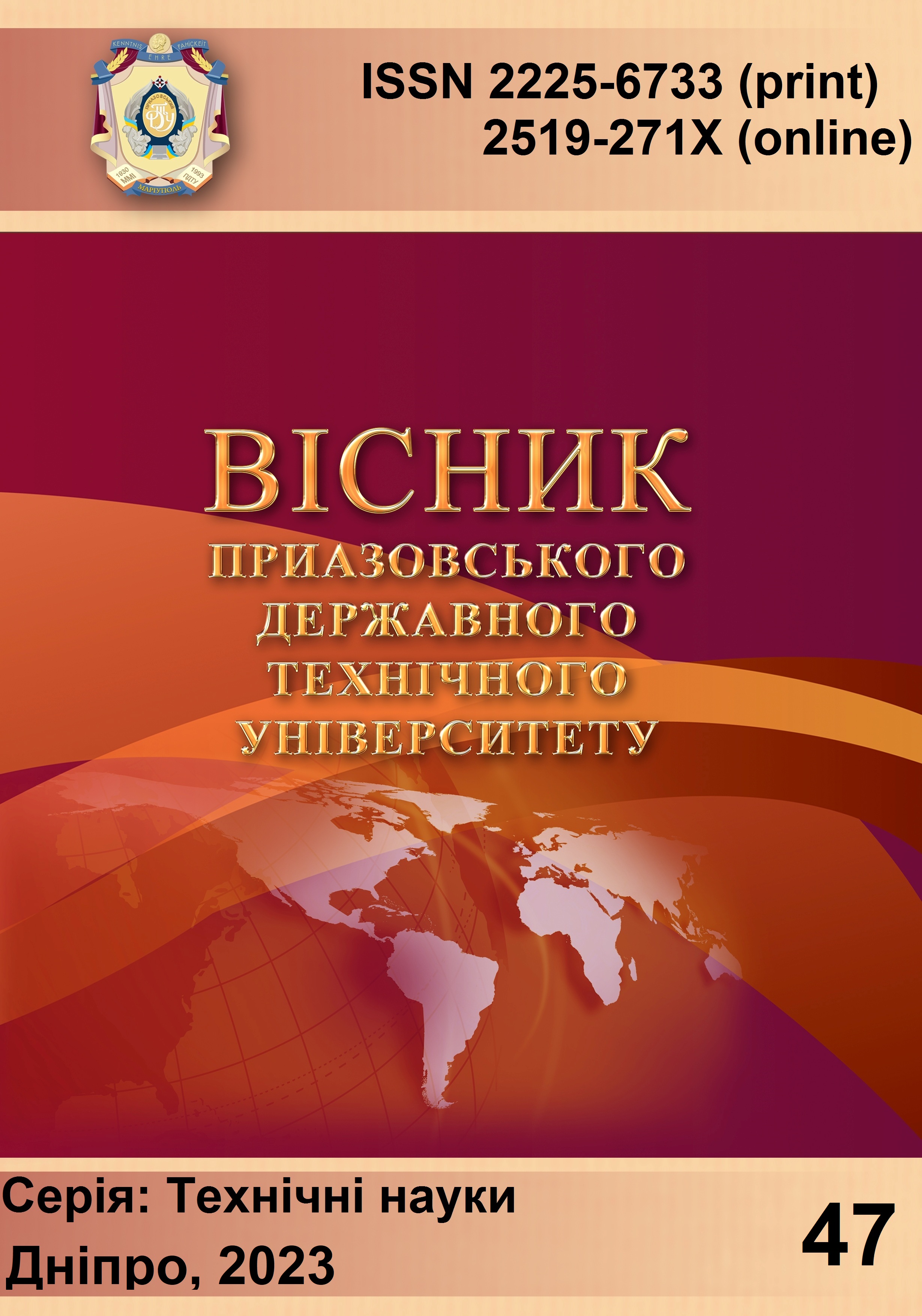Відновлення зношеного обладнання комплексним методом 3-D сканування та друку
DOI:
https://doi.org/10.31498/2225-6733.47.2023.300054Ключові слова:
3D-принтер, сканер, композит, реставрація, обладнання, технологія, PEEKАнотація
Реставрація обладнання – складний процес, який потребує комплексного підходу. Зношування деталей і вузлів великогабаритного обладнання призводить до зупинки технологічних процесів, зниження продуктивності, а іноді й до повного виходу з ладу всього виробничого ланцюга. У більшості випадків ремонт на місці неможливий. Однак сучасні технології CAD дозволяють не тільки оцінити ступінь зносу, але й підказують шлях до відновлення. Широке поширення 3D-друку значно спростило процес створення окремих деталей. Однак висока точність готового виробу багато в чому залежить від якості моделі. Швидке отримання високоточної моделі можливо за допомогою 3D-сканера. Однак великий вибір 3D обладнання, а також матеріалів, що вимагають особливих умов, значно ускладнює прогнозування якості готового продукту. Мета роботи – вивчити етапи ремонту деталей за допомогою 3D сканування та 3D друку, забезпечити значення точності отриманих моделей та якість готових деталей на прикладі деталі з напівкристалічного матеріалу PEEK. Аргументовано економічну доцільність 3D-друку зношених деталей. Розглянуто прямі та непрямі методи реставрації. Надаються значення точності, отримані під час друку таких матеріалів, як PAI2, PP, TPU, ABS, PEEK. Визначено умови 3D-друку поліефіркетону PEEK, а також оптимальні характеристики для отримання матеріалу з найвищою зносостійкістю. Перспективним і доцільним рішенням є застосування комплексного методу відновлення зношених деталей за допомогою 3D-друку та сканування. Проте, незважаючи на високу точність та якість сучасного методу, проведений аналіз свідчить про необхідність вивчення питань кріплення деталей зношених елементів та адгезії використовуваних матеріалів
Посилання
Hollander M.C.D., Bakker C.A. A business model framework for product life extension / M.C.D. Hollander. 17th International Conference Sustainable Innovation, Bonn, Germany, 29-30 October 2012. Pp. 110-118.
Kin S.T.M., Ong S.K., Nee A.Y.C. Remanufacturing process planning. Procedia CIRP. 2014. Vol. 15. Pp. 189-194. DOI: https://doi.org/10.1016/j.procir.2014.06.087.
Efficiency of 3D-printed composite resin restorations compared with subtractive materials: Eval-uation of fatigue behavior, cost, and time of production / R. Daher, S. Ardu, E. di E. Bella, I. Krejci, O. Duc. The Journal of Prosthetic Dentistry. November 2022. Pp. 1-8. DOI: https://doi.org/10.1016/j.prosdent.2022.08.001.
Sustainability perspectives – a review of additive and subtractive manufacturing / H. Jayaward-ane, I.J. Davies, J.R. Gamage, M. John, W.K. Biswas. Sustainable Manufacturing and Service Economics. 2023. Vol. 2. Pp. 1-12. DOI: https://doi.org/10.1016/j.smse.2023.100015.
A comparison of energy consumption in bulk forming, subtractive, and additive processes: Review and case study / H.-S. Yoon, J.-Y. Lee, H.-S. Kim, M.-S. Kim, E.-S. Kim, Y.-J. Shin, W.-S. Chu, and S.-H. Ahn. International Journal of Precision Engineering and Manufacturing-Green Technology. 2014. Vol. 1. Pp. 261-279. DOI: https://doi.org/10.1007/s40684-014-0033-0.
Yao A.W. Applications of 3D scanning and reverse engineering techniques for quality control of quick response products. International Journal of Advanced Manufacturing Technology. 2005. Vol. 26(11-12). Pp. 1284-1288. DOI: https://doi.org/10.1007/s00170-004-2116-5.
Larue J.F., Brown D., Viala M. How optical CMMs and 3D scanning will revolutionize the 3D metrology world. Integrated Imaging and Vision Techniques for Industrial Inspection. 2015. Pp. 141-176. DOI: https://doi.org/10.1007/978-1-4471-6741-9_5.
E-quality control in dental metal additive manufacturing inspection using 3D scanning and 3D measurement / L. Du, Y. Lai, C. Luo, Y. Zhang, J. Zheng, X. Ge, Y. Liu. Frontiers in Bioengi-neering and Biotechnology. 2020. Vol. 8. Pp. 1-9. DOI: https://doi.org/10.3389/fbioe.2020.01038.
Dombroski C.E., Balsdon M.E., Froats A. The use of a low-cost 3D scanning and printing tool in the manufacture of custom-made foot orthoses: A preliminary study. BMC Research Notes. 2014. Vol. 7. Pp. 1-4. DOI: https://doi.org/10.1186/1756-0500-7-443.
Haleem A. 3D scanning applications in the medical field: A literature-based review. Clinical Epidemiology and Global Health. 2019. Vol. 7(2). Pp. 199-210. DOI: https://doi.org/10.1016/j.cegh.2018.05.006.
Exploring the potential of 3D scanning in Industry 4.0: An overview / A. Haleem, M. Javaid, R.P. Singh, S. Rab, R. Suman, L. Kumar, I.H. Khan. International Journal of Cognitive Computing in Engineering. 2022. Vol. 3. Pp. 161-171. DOI: https://doi.org/10.1016/j.ijcce.2022.08.003.
Gaub H. Customization of mass-produced parts by combining injection molding and additive manufacturing with Industry 4.0 technologies. Reinforced Plastics. 2016. Vol. 60(6). Pp. 401-404. DOI: https://doi.org/10.1016/j.repl.2015.09.004.
3D scanning of a carburetor body using COMET 3D scanner supported by COLIN 3D software: Issues and solutions / Haleem A., Gupta P., Bahl S., Javaid-Kumar M.L. Materials Today Pro-ceeding. 2021. Vol. 39. Part 1.P. 331-337. DOI: https://doi.org/10.1016/j.matpr.2020.07.427.
Javaid M., Haleem A. Using additive manufacturing applications for design and development of food and agricultural equipments. International Journal of Materials and Product Technology. 2019. Vol. 58(2-3). Pp. 225–238. DOI: https://doi.org/10.1504/IJMPT.2019.10018137.
Lee D.K., Park B.Y. A case study for 3D scanning-based quantitative quality control during key stages of composite small craft production. International Journal of Naval Architecture and Ocean Engineering. 2023. Vol. 15. 100534. DOI: https://doi.org/10.1016/j.ijnaoe.2023.100534.
Vagovský J., Buranský I., Görög A. Evaluation of Measuring Capability of the Optical 3D Scan-ner. Procedia Engineering. 2015. Vol. 100. Pp. 1198-1206. DOI: https://doi.org/10.1016/j.proeng.2015.01.484.
Anisotropy and heterogeneity of microstructure and mechanical properties in metal additive manufacturing: a critical review / Y. Kok, X.P. Tan, P. Wang, M.L.S. Nai, N.H. Loh, E. Liu, S.B. Tor. Materials & Design. 2017. Vol. 139. Pp. 565-586. DOI: https://doi.org/10.1016/j.matdes.2017.11.021.
Lyalyakin V.P., Kostukov A.Y., Denisov V.A. Special features of reconditioning the housing of a Caterpillar diesel oil pump by gas-dynamic spraying. Welding International. 2016. Vol. 30(1). Pp. 68-70. DOI: https://doi.org/10.1080/09507116.2015.1030152.
Cold spray additive manufacturing and repair: fundamentals and applications / S. Yin, P. Cava-liere, B. Aldwell, R. Jenkins, H. Liao, W. Li, R. Lupoi. Additive Manufacturing. 2018. Vol. 21. Pp. 628-650. DOI: https://doi.org/10.1016/j.addma.2018.04.017.
Intelligent systems for additive manufacturing-based repair in remanufacturing: A systematic review of its potential / Syahara M.Y.S., Dzuraidah A.W., Hiyam A.H., Abdul H.A. PeerJ Com-puter Science. 2021. Vol. 7(17). Pp. 1-34. DOI: https://doi.org/10.7717/peerj-cs.808.
Selective Laser Melting of a 1U CubeSat structure. Design for Additive Manufacturing and as-sembly / A. Boschetto, L. Bottini, M. Eugeni, V. Cardini, G.G. Nisi, F. Veniali, P. Gaudenzi. Acta Astronautica. 2019. Vol. 159. Pp. 377-384. DOI: https://doi.org/10.1016/j.actaastro.2019.03.041.
Automatic fault detection for laser powder-bed fusion using semi-supervised machine learning / I.A. Okaro, S. Jayasinghe, C. Sutcliffe, K. Black, P. Paoletti, P.L. Green. Additive Manufactur-ing. 2019. Vol. 27. Pp. 42-53. DOI: https://doi.org/10.1016/j.addma.2019.01.006.
Trends and research challenges in remanufacturing / Matsumoto M., Yang S., Martinsen K., Kainuma Y. International Journal of Precision Engineering and Manufacturing-Green Technology. 2016. Vol. 3(1). Pp. 129-142. DOI: https://doi.org/10.1007/s40684-016-0016-4.
Application of high-pressure cold spray for an internal bore repair of a navy valve actuator / C.A. Widener, M.J. Carter, O.C. Ozdemir, R.H. Hrabe, B. Hoiland, T.E. Stamey, T.J. Eden. Journal of Thermal Spray Technology. 2016. Vol. 25(1-2). Pp. 193-201. DOI: https://doi.org/10.1007/s11666-015-0366-4.
Jafferson J.M., Chatterjee D. A review on polymeric materials in additive manufacturing. Materials Today: Proceedings. 2021. Vol. 46. Part 2. Pp. 1349-1365. DOI: https://doi.org/10.1016/j.matpr.2021.02.485.
Experimental and computational study on thermal and fluid behaviors of powder layer during selective laser melting additive manufacturing / Chen H., Zhang Y., Giam A., Yan W. Additive Manufacturing. 2022. Vol. 52. 102645. DOI: https://doi.org/10.1016/j.addma.2022.102645.
Selective laser melting of magnesium alloys: Necessity, formability, performance, optimization and applications / K. Li, C. Ji, S. Bai, B. Jiang, F. Pan. Journal of Materials Science & Technolo-gy. 2023. Vol. 154. Pp. 65-93. DOI: https://doi.org/10.1016/j.jmst.2022.12.053.
Aghajani Derazkola H., Khodabakhshi F., Simchi A. Evaluation of a polymer-steel laminated sheet composite structure produced by friction stir additive manufacturing (FSAM) technology. Polymer Testing. 2020. Vol. 90. 106690. DOI: https://doi.org/10.1016/j.polymertesting.2020.106690.
Iron oxide supercapacitor of high volumetric energy and power density using binder-free super-sonic spraying and self-healing rGO / T. Kim, E. Samuel, C. Park, A. Aldalbahi, M. El-Newehy, Y. Kang, H.S. Lee, S.S. Yoon. Ceramics International. 2022. Vol. 48(10). Pp. 13684-13694. DOI: https://doi.org/10.1016/j.ceramint.2022.01.250.
Low-cost and low-temperature 3D printing for refractory composite inspired by fused deposition modeling and binder jetting / L. Zhuo, C. Liu, E. Yin, Z. Zhao, S. Pang. Composites Part A: Ap-plied Science and Manufacturing. 2022. Vol. 162(6). 107147. DOI: https://doi.org/10.1016/j.compositesa.2022.107147.
Beehag A., Ye L. Role of cooling pressure on interlaminar fracture properties of commingled CF/PEEK composites. Composites Part A: Applied Science and Manufacturing. 1996. Vol. 27. Iss. 3. Pp. 175-182. DOI: https://doi.org/10.1016/1359-835X(95)00027-Y.
Preparation of three-dimensional braided carbon fiber-reinforced PEEK composites for potential load-bearing bone fixations. Part I. Mechanical properties and cytocompatibility / H. Luo, G. Xiong, Z. Yang, S.R. Raman, Q. Li, C. Ma, D. Li, Z. Wang, Y. Wan. Journal of the Mechanical Behavior of Biomedical Materials. 2014. Vol. 29. Pp. 103-113. DOI: https://doi.org/10.1016/j.jmbbm.2013.09.003.
Optimization of processing conditions and mechanical properties for PEEK/PEI multilayered blends / S.A. Toro, A. Ridruejo, C. González, M.A. Monclús, J.P. Fernández-Blázquez. Poly-mers. 2022. Vol. 14(21). Pp. 1-12. DOI: https://doi.org/10.3390/polym14214597.
Zayas-Figueras E., Buj-Corral I. Comparative study about dimensional accuracy and surface fin-ish of constant-breadth cams manufactured by FFF and CNC milling. Micromachines. 2023. Vol. 14(2). Pp. 1-16. DOI: https://doi.org/10.3390/mi14020377.
Buj-Corral I., Zayas-Figueras E. Comparative study about dimensional accuracy and form errors of FFF printed spur gears using PLA and Nylon. Polymer Testing. 2023. Vol. 117. 107862. DOI: https://doi.org/10.1016/j.polymertesting.2022.107862.
Braun K., Willenborg E., Schleifenbaum J.H. Laser polishing as a new post process for 3D-printed polymer parts. Procedia CIRP. 2020. Vol. 94. Pp. 134-138. DOI: https://doi.org/10.1016/j.procir.2020.09.026.
Cirino M., Pipes R.B., Friedrich K. The abrasive wear behavior of continuous fiber polymer composites. Journal of Materials Science. 1987. Vol. 22. Pp. 2481-2492. DOI: https://doi.org/10.1007/BF01082134.
##submission.downloads##
Опубліковано
Як цитувати
Номер
Розділ
Ліцензія
Журнал "Вісник Приазовського державного технічного університету. Серія: Технічні науки" видається під ліцензією СС-BY (Ліцензія «Із зазначенням авторства»).
Дана ліцензія дозволяє поширювати, редагувати, поправляти і брати твір за основу для похідних навіть на комерційній основі із зазначенням авторства. Це найзручніша з усіх пропонованих ліцензій. Рекомендується для максимального поширення і використання неліцензійних матеріалів.
Автори, які публікуються в цьому журналі, погоджуються з наступними умовами:
1. Автори залишають за собою право на авторство своєї роботи та передають журналу право першої публікації цієї роботи на умовах ліцензії Creative Commons Attribution License, яка дозволяє іншим особам вільно розповсюджувати опубліковану роботу з обов'язковим посиланням на авторів оригінальної роботи та першу публікацію роботи в цьому журналі.
2. Автори мають право укладати самостійні додаткові угоди, які стосуються неексклюзивного поширення роботи в тому вигляді, в якому вона була опублікована цим журналом (наприклад, розміщувати роботу в електронному сховищі установи або публікувати у складі монографії), за умови збереження посилання на першу публікацію роботи в цьому журналі.









